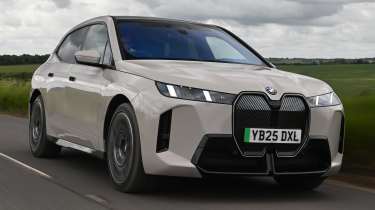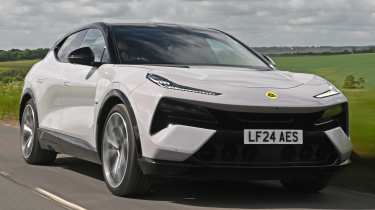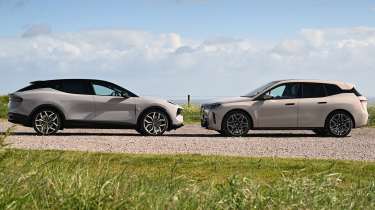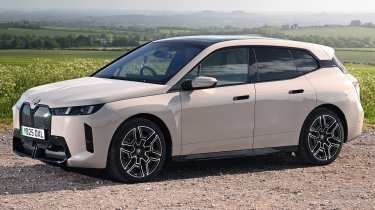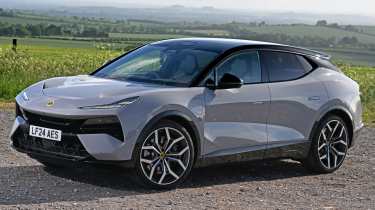BMW iX vs Lotus Eletre: Britain vs Germany in electric SUV dogfight
British hyper-SUV has refreshed German champion in its sights
Large SUVs are always about making a statement. Bold looks that sometimes border on the brash, sumptuous luxury and often a mantra of “bigger is better” sum up these creations. With electric power, they can deliver stronger performance than their ICE ancestors, and battery tech is finally reaching the point where range is no longer a worry.
Few premium SUVs delivered as much shock and awe as the BMW iX did on its arrival four years ago. The shock was obvious, because many BMW fans struggled to come to terms with the divisive looks. The awe came from those who drove it; this was a car that blew the competition clean out of the water.
Now, there’s a fully updated version, which led us to the question: which large, electric SUV would have the best shot of taking its crown?
Step forward the Lotus Eletre. Times for the brand might be a little turbulent, but that’s not the fault of its products; the mind-blowing Evija hypercar and the superb Emeya five-door are both strong additions to Hethel’s sports-car roots, still strongly represented by the Emira. But does its flagship SUV have what it takes to overcome the iX? Previous encounters suggest the BMW is in for a tough fight.
BMW iX
| Model | BMW iX xDrive45 M Sport |
| Price: | £78,405 |
| Powertrain: | 100.6kWh battery, 2x e-motors, 402bhp |
| 0-62mph: | 5.1 seconds |
| Test efficiency: | 3.5 miles/kWh |
| Official range: | 367 miles |
| Annual VED: | £620 |
Since its release in 2021, the iX has proved to be an incredibly tough car to beat in the large premium SUV class, seeing off one rival after another in all our group tests. Don’t think for a minute that its success has caused BMW to let any complacency set in, though; a raft of mid-life updates have been introduced to improve the car’s performance, efficiency and in-car tech. The entry-level xDrive45 model on test here replaces the outgoing xDrive40, and in M Sport trim it costs £78,405.
Tester’s notes
All of the small efficiency tweaks no doubt help the iX to eke out every last fraction of a mile per kilowatt-hour, but the fundamental structure no doubt helps, too. BMW’s CLAR platform uses carbon fibre extensively, and often it’s clear to see its use – just look at the door opening and sills to see exposed sections of the material.
Used - available now

2022 Nissan
Qashqai
29,772 milesManualPetrol1.3L
Cash £14,497
2021 Hyundai
Ioniq hybrid
64,713 milesAutomaticPetrol1.6L
Cash £12,476
2017 BMW
1 Series
39,421 milesManualPetrol1.5L
Cash £10,997
2023 Audi
Q4 e-tron
8,432 milesAutomaticElectric
Cash £26,197At 0.25Cd, the coefficient of drag is fairly low for such a big vehicle, too, although that large frontal area means that it will still not cut through the air as cleanly as one of the brand’s smaller models.
Lotus Eletre
| Model | Lotus Eletre 600 Sport SE |
| Price: | £86,715 |
| Powertrain: | 112kWh battery, 2x e-motors, 603bhp |
| 0-62mph: | 4.5 seconds |
| Test efficiency: | 2.4 miles/kWh |
| Official range: | 305 miles |
| Annual VED: | £620 |
To many, the thought of a Lotus SUV will jar against the ethos of a brand famed for its lightweight sports cars. But the harsh reality of the modern car industry is that if low-volume sports cars are to remain, then more popular and profitable models need to exist alongside them; it’s a strategy which Porsche executed with huge success with the Cayenne and later the Macan. The Eletre looks competitively priced compared with the iX on paper, with the 600 model starting from £86,715.
Tester’s notes
The Eletre is available with a sound system by British audio firm KEF. Not only do the exposed speaker cones look beautifully intricate, but the 1,380-watt 15-speaker set-up has plenty of punch, too. Many in-car systems are undone by the drone of wind and tyre noise, but not this one; noise-cancelling tech helps here, but the fact that the audio is so crisp and powerful helps, too. In terms of quality, it’s right up there with BMW’s uprated Bowers and Wilkins set-up – itself among the best systems on the market.
Head to head
On the road
Both cars ride and handle impressively, but the BMW delivers a better overall package. The Eletre is slightly sharper, especially when pushed hard, but the iX runs it close while returning superior ride comfort and refinement. The Eletre’s main advantage from behind the wheel is the wheel itself. The steering feels a little more naturally weighted than the BMW’s and the thinner, firmer rim is nicer to hold.
Tech highlights
BMW has overhauled its EV powertrain set-up for the iX, bringing more efficiency and power; the base xDrive45 now produces 402bhp. That’s some way short of the Eletre, whose line-up kicks off with 603bhp. Go for the range-topper and there’s 905bhp on tap, enough for a 2.95-second 0-62mph time. Both cars get air suspension and the Eletre’s hunkers down into the road at higher speeds to reduce drag.
Price and running
While energy efficiency won’t be at the forefront of buyers’ minds at this price point in running cost terms, the BMW’s stronger scores in this area enable it to travel much further on a charge. At 2.4 miles/kWh, the Lotus achieved around 260 miles in our hands; the BMW, despite a battery whose net capacity is 13kWh smaller than its rival’s, could cover more than 330 miles between top-ups – a big advantage.
Practicality
Neither car is short on space. Headroom is seemingly endless in the iX, while the flat floor makes the cabin feel light, airy and spacious. The Eletre is very marginally tighter above than the BMW, but nothing else in the segment comes close for knee room – it’s simply vast. An optional four-seat package makes the Lotus’s rear quarters feel even more opulent, with superbly comfortable massaging seats.
Safety
The BMW iX scored a maximum five-star Euro NCAP rating when it was tested in 2022, and every model has adaptive cruise control. The Lotus Eletre hasn’t been tested by the organisation, although it is loaded with standard driver-assistance tech, which uses LiDAR sensors to maintain the car’s speed and position within a lane. Digital side mirrors are also optional, although we still prefer the standard units.
Ownership
The Eletre’s five-year warranty beats the iX’s by 24 months. When it comes to charging, the Lotus is a very clear winner. While the revised iX gets improved charging speeds of 175kW (and 195kW on range-topping models), the Eletre can be refreshed at up to 350kW. Find a charger that can keep up, and it means that a 10-80 per cent charge takes just 20 minutes. A 10-80 per cent top-up in the BMW takes 34 minutes.
Verdict
Winner: BMW iX
The iX has long been our favourite in this segment, and the mid-life revisions have only cemented victory here against a Lotus which did prove to be a match in some areas. But in almost every classification that matters, the BMW scores superbly; comfort, refinement, space and performance are all great.
Best of all, the changes to the powertrain and running gear have addressed the middling efficiency of the iX, one of the only weaknesses of the previous model. Now, BMW’s EV leads its class there, too. More than ever, those in the market for a posh electric SUV have a clear number one candidate.
Runner-up: Lotus Eletre
Lotus entered the EV market (Evija hypercar aside) with two closely related high-end offerings. Of those two, the Eletre SUV isn’t quite as convincing as the Emeya saloon, nor does it quite have the talent to overcome the BMW iX in this contest.
There are still many big positives to take here – notably the generous back seat-space – while the cabin feels unique and luxurious, the handling is great and there’s excellent performance, too. But in one or two areas that matter in this class – ride comfort and, in particular, range – the Eletre can’t match its rival. It’s a deeply capable car, however.
Prices and specs
| Model tested | BMW iX xDrive45 M Sport | Lotus Eletre 600 Sport SE |
| Price from/price as tested | £78,405/£91,200 | £86,715/£104,990 |
| Powertrain and performance | ||
| Powertrain | 2x electric motors | 2x electric motors |
| Power | 402bhp | 603bhp |
| Torque | 700Nm | 710Nm |
| Transmission | Single speed/AWD | Single speed/AWD |
| 0-62mph/top speed | 5.1 secs/124mph | 4.5 secs/155mph |
| Battery capacity/usable | 100.6/94.8kWh | 112/109kWh |
| Official range | 367 miles | 305 miles |
| Dimensions | ||
| Length/wheelbase | 4,965/3,000mm | 5,103/3,019mm |
| Width/height | 1,970/1,695mm | 2,019/1,636mm |
| Rear knee room | 635-885mm | 682-947mm (four-seat layout) |
| Rear headroom/elbow room | 1,006/1,580mm | 951/1,571mm |
| Boot space (front/seats up/down) | N/A/500/1,750 litres | 46/688 (to roof)/1,532 litres |
| Boot length/width | 1,055/1,106mm | 1,072/1,044mm |
| Boot lip height | 762mm | 700mm (air suspension lowered) |
| Kerbweight/towing weight | 2,525/2,500kg | 2,645kg/N/A |
| Turning circle | 12.8 metres | 12.0 metres |
| Costs/ownership | ||
| Residual value (after 3yrs/36,000 miles) | £42,007/46.06% | £50,962/48.54% |
| Depreciation | £36,398 | £35,753 |
| Insurance group/quote/VED | 50/£1,229/£620 | 50/£1,204/£620 |
| Three-year service cost | £910 | £1,749 (five years) |
| Annual tax liability std/higher rate | £470/£940 | £537/£1,073 |
| Annual fuel cost (10k/20k miles) | £735 | £1,072 |
| Basic warranty (miles)/recovery | 3yrs (60,000)/3 yrs | 5yrs (100,000)/3 yrs |
| Driver Power manufacturer position | 14th (out of 32) | N/A |
| NCAP Adult/child/ped./assist/stars | 91/87/73/81/5 _ (2022) | N/A |
| Equipment | ||
| Metallic paint/wheel size | £900/21 inches | £0/22 inches |
| Parking sensors/camera | F&r/yes | F&r/yes |
| Spare wheel/Isofix points | Repair kit/two | Repair kit/two |
| Keyless entry & go/powered tailgate | Yes/yes | Yes/yes |
| Leather/heated seats | Yes/yes | £2,000/yes |
| Screen size/digital dashboard | 14.9 inches/yes | 15.1 inches/yes |
| Climate control/panoramic sunroof | Yes/£3,200 | Yes/yes |
| USBs/wireless charging | Four/yes | Four/yes |
| Wireless CarPlay/Android Auto | Yes/yes | Yes/yes |
| Blind-spot warning/head-up display | Yes/yes | Yes/yes |
| Adaptive cruise/steering assist | Yes/yes | Yes/yes |
What we would choose
BMW iX
Our test car featured almost every added pack available. While the £3,200 panoramic roof is great, it’s pricey. The Comfort Pack, which adds ventilated seats, rear-seat heating and more, looks good value for money, at £1,650.
Lotus Eletre
The Eletre comes in a range of trim levels, but the exterior colour options are fairly limited. The £5,500 Executive Pack is a luxurious optional indulgence if you don’t need a middle seat in the back.
Looking for your next car? You can now search our nationwide dealer network for a choice of great cars on offer right now with new, used and leasing deals to choose from...

